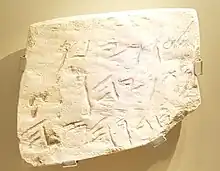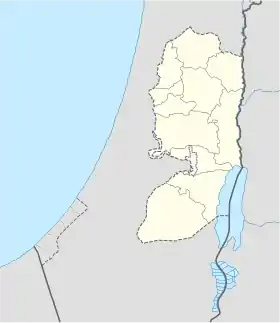 One of the burial inscription from the site | |
 Shown within the West Bank | |
| Location | |
|---|---|
| Coordinates | 31°32′4.98″N 34°57′59.63″E / 31.5347167°N 34.9665639°E |
| History | |
| Founded | 20 BCE |
| Periods | Early Bronze Age - Hellenistic period |
| Cultures | Canaanite, Israelite, Edomite, Second Temple Judaism |
| Site notes | |
| Excavation dates | 1967-8 |
| Archaeologists | William G. Dever |
| Condition | In ruins |
| Public access | yes |
Khirbet el-Qom (Arabic: خربة الكوم) is an archaeological site in the village of al-Kum, West Bank, in the territory of the biblical Kingdom of Judah, between Lachish and Hebron, 14 km to the west of the latter.
Excavations
Archaeological excavations were conducted at the site in 1967 by William G. Dever on behalf of the Hebrew Union College.[1]
Findings
Iron Age

Two Iron Age bench tombs carved into natural rock were discovered at el-Qom; both were investigated by William Dever in 1967 following their discovery by tomb robbers.[2] Both tombs contain inscriptions, dating from the second half of the 8th century BCE,[3] slightly after the Asheratic Kuntillet Ajrud inscriptions. The inscription from Tomb 2 is associated with a "magic hand" symbol, and reads:
Unlike the Kuntillet Ajrud inscriptions, this inscription do not include a place name with the name of Yahweh (the Kuntillet Ajrud inscriptions talk of "Yahweh of Samaria" and "Yahweh of Teman"); this seems to indicate that they were written after the fall of Samaria, which left Yahweh as the god of one state only.[6]
the inscriptions from Khirbet el-Qom and Kuntillet Ajrud, alongside with great Levantine archives such as Ebla archive, Ugarit archive and Mari archive, were important factors in the reconceptualization of the ancient Israelite religion and its understanding as a part and parcel of its Near Eastern/Levantine/West Semitic/Canaanite environment.[7][8]
There is some scholarly debate about the translation, particularly for line three.[9][10]
A jug inscribed "to/for Yahmol" and a bowl inscribed "El" were also found.[11]
Persian and Hellenistic periods
One thousand seven hundred ostraca in Aramaic may have been found on the site and the vicinity, dating from the Persian and Hellenistic periods, during which the area was classified as the Persian province of Idumea, with a mixed population of Edomites, Jews and Arabs.[12] The site is called Maqqedah in the Idumean ostraca.[13] Based on this, some scholars identify Khirbet el-Qom with biblical Makkedah (Joshua 10:10, 16, 17, 21, 28, 29; 12:16; 15:41).[14]
Roman period
A burial cave in El-Qom contained three Hebrew funerary inscriptions dating from the 1st century BCE to the 2nd century CE, bearing names such as Miriam and Shalom. Currently, they are housed in the Israel Antiquities Authority storage facilities in Beit Shemesh.[15]
Identification
Based on the findings and the possible name preservation of the ancient name in the adjacent valley of Wadi es-Safir, it has been suggested that Khirbet el-Qum is Shafir, a place mentioned in the Book of Micah (1:11).[16]
See also
- Revadim Asherah
- Biblical archaeology
- Cities of the ancient Near East
- History of ancient Israel and Judah
- Kuntillet Ajrud inscriptions - similarly judean[17] and roughly contemporaneous epigraphy[18]
Bibliography
- Zevit, Ziony (1984). "The Khirbet el-Qôm Inscription Mentioning a Goddess". Bulletin of the American Schools of Oriental Research. American Schools of Oriental Research (255): 39–47. ISSN 0003-097X. JSTOR 1357074. Retrieved 2023-11-08.
References
- ↑ Dever, William G. 1969–1970. "Iron Age Epigraphic Material from the Area of Khirbet El-Kôm.", Hebrew Union College Annual 40–41: 139–204
- ↑ Zevit, Ziony. “The Khirbet El-Qôm Inscription Mentioning a Goddess.” Bulletin of the American Schools of Oriental Research, no. 255, 1984, pp. 39–47
- ↑ Hadley, Judith M. (1987). "The Khirbet el-Qom Inscription". Vetus Testamentum. 37 (1): 50–62. doi:10.2307/1517810. ISSN 0042-4935. JSTOR 1517810.
- ↑ Keel, Othmar, and Uehlinger, Christoph, "Gods, goddesses, and images of God in ancient Israel" (Fortress Press, 1998) p.239.
- ↑ Meindert Djikstra, I Have Blessed you by YHWH of Samaria and his Asherah: Texts With Religious Elements from the Soil Archive of Ancient Israel, in Bob Becking, (ed), "Only One God? Monotheism in Ancient Israel and the Veneration of the Goddess Asherah" (Sheffield Academic Press, 2001), p.p.32-34
- ↑ Keel, Othmar, and Uehlinger, Christoph, "Gods, goddesses, and images of God in ancient Israel" (Fortress Press, 1998) p.239.
- ↑ Dever, William G. (1999). "Archaeology and the Ancient Israelite Cult: How the Kh. El-Qôm and Kuntillet ʿajrûd 'Asherah' Texts Have Changed the Picture". Eretz-Israel. 26: 9*–15*. ISSN 0071-108X.
- ↑ Uehlinger, Christoph (2015). "Distinctive or diverse? Conceptualizing ancient Israelite religion in its southern Levantine setting". Hebrew Bible and Ancient Israel (HeBAI). 4 (1): 12, 14. doi:10.1628/219222715X14343676549106. ISSN 2192-2276.
- ↑ Shea, William H. “The Khirbet El-Qom Tomb Inscription Again.” Vetus Testamentum, vol. 40, no. 1, 1990, pp. 110–16
- ↑ Margalit, Baruch. “Some Observations on the Inscription and Drawing from Khirbet El-Qôm.” Vetus Testamentum, vol. 39, no. 3, 1989, pp. 371–78
- ↑ Alice Mandell, and Jeremy Smoak. "Reading and Writing in the Dark at Khirbet El-Qom: The Literacies of Ancient Subterranean Judah." Near Eastern Archaeology, vol. 80, no. 3, 2017, pp. 188–95
- ↑ André Lemaire, 'Edom and the Edomites,' in André Lemaire, Baruch Halpern (eds.), The Books of Kings: Sources, Composition, Historiography and Reception, BRILL 2010pp.225-245 p.243.
- ↑ David F. Graf, 'Petra and the Nabataeans in the Early Hellenistic Period: the literary and archaeological evidence,' in Michel Mouton,Stephan G. Schmid (eds.), Men on the Rocks: The Formation of Nabataean Petra, Logos Verlag Berlin GmbH, 2013 pp.35-55 p.47
- ↑ Diana Vikander Edelman, The Origins of the Second Temple: Persion Imperial Policy and the Rebuilding of Jerusalem, Routledge 2005, ISBN 9781845530174, p. 265
- ↑ Corpus inscriptionum Iudaeae/Palaestinae: a multi-lingual corpus of the inscriptions from Alexander to Muhammad. Vol. IV: Iudaea / Idumaea. Eran Lupu, Marfa Heimbach, Naomi Schneider, Hannah Cotton. Berlin: de Gruyter. 2018. pp. 1237–1241. ISBN 978-3-11-022219-7. OCLC 663773367.
{{cite book}}: CS1 maint: others (link) - ↑ Kochavi, Moshe, ed. (1972). Judaea, Samaria and the Golan: Archaeological Survey 1967-1968 (in Hebrew). Jerusalem: Carta. p. 29.
- ↑ Zevit 1984, p. 46.
- ↑ Margalit, Baruch (1989). "Some Observations on the Inscription and Drawing from Khirbet el-Qôm". Vetus Testamentum. Brill. 39 (3): 371–378. ISSN 0042-4935. JSTOR 1519611. Retrieved 2023-11-08.